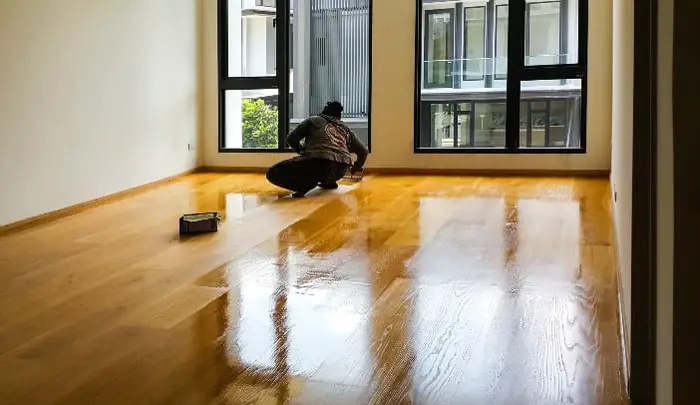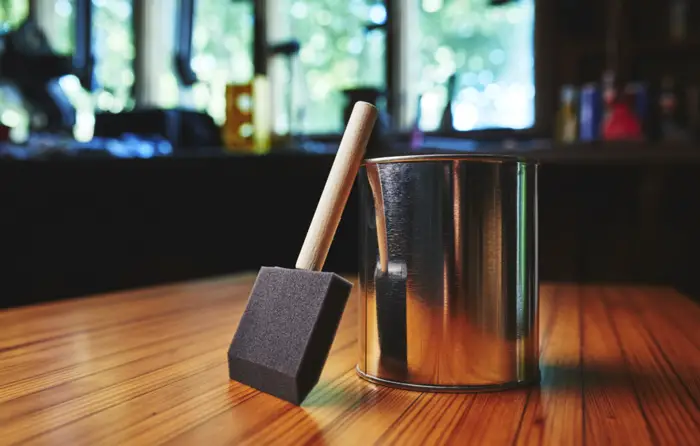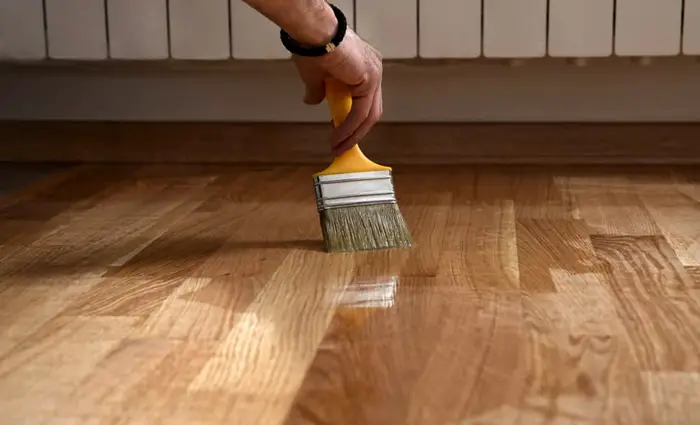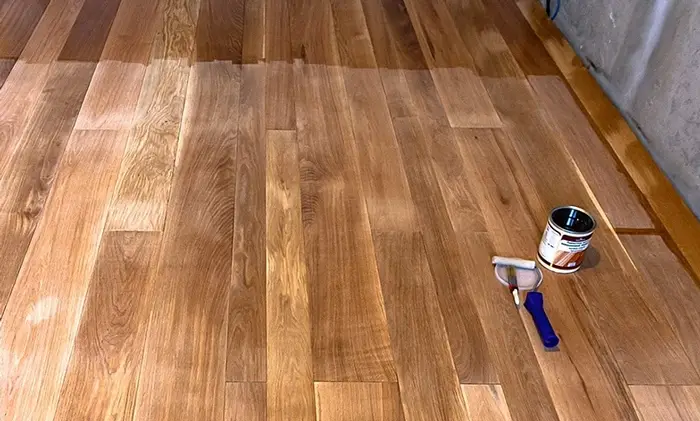Can You Sleep In House After Polyurethane? What Are The Risks?
Polyurethane application is a common practice for providing durability and protection to various surfaces during home improvement projects. However, once the polyurethane has been applied, a critical question arises: Is it safe to sleep in a house where polyurethane has been used?
Can you sleep in house after polyurethane? No, you cannot sleep in a polyurethane-treated room immediately after it has been applied. The off-gassing of volatile organic compounds (VOCs) during drying processes can be hazardous to one’s health.
This article will provide you with a clear understanding of the safety considerations for inhabiting a space after polyurethane application. We will also discuss the appropriate waiting periods based on the type of polyurethane used and how to eliminate the polyurethane smell.
Can You Sleep In House After Polyurethane?
As previously stated, you cannot sleep in a house after polyurethane treatment. This is due to a phenomenon known as off-gassing. Off-gassing is the release of volatile organic compounds (VOCs) from materials such as polyurethane during the drying and curing processes.

These VOCs change from liquid to gaseous state, emitting potentially harmful fumes into the air. Both water-based and oil-based polyurethane emits VOCs during the curing process. These compounds include chemicals such as formaldehyde and benzene, which can be harmful to human health.
Thus, these effects are particularly concerning for individuals with preexisting respiratory conditions, allergies, or sensitivities to chemicals.
How Long Do Polyurethane Fumes Last?
Polyurethane fumes can linger in your home for up to 30 days after application. The VOCs emitted during the drying and curing processes have the potential to adhere to a variety of surfaces, including walls, curtains, and furniture.
This means that even if the initial concentration of fumes decreases as the poly dries, traces of these compounds may still be present in your surroundings. This lingering effect is especially concerning because the chances of inhaling these potentially harmful gasses remain high.

However, this issue has resulted in disagreements among experts regarding re-entry guidelines. Some recommend re-entry after the polyurethane has dried, while others advise waiting until it has cured.
After extensive research, we came to the conclusion that you can re-enter your home once the polyurethane has dried. This is because VOCs completely evaporate as polyurethane dries.
How Long Should You Wait to Re-enter Your House After Polyurethane Application?
The amount of time you must wait before reentering your home is determined by the type of polyurethane used and the level of ventilation.

Water-based polyurethane emits fewer volatile organic compounds (VOCs) and dries faster. This is because water evaporates faster than oil-based solvents. As a result, you should be able to re-enter your home within 5-7 days of applying.
Oil-based polyurethane, on the other hand, necessitates a longer wait before re-entry. Because of the higher VOC content and slower drying rate, it’s best to wait at least a week before returning to your living spaces.
It is important to note that the waiting period is also affected by the size of the treated area and the efficiency of the ventilation. Larger spaces may require more time for VOCs to disperse, and inadequate ventilation can prolong the off-gassing period.
How Does Polyurethane Affect Your Health?
VOCs emitted by polyurethane can affect individuals in various ways, ranging from short-term irritations to potential long-term health risks. Here are the risks of polyurethane to your health.

Short-Term Effects
- Irritation: The fumes can irritate the eyes, nose, throat, and skin, causing discomfort and temporary inflammation.
- Respiratory Symptoms: Inhaling the fumes may lead to respiratory symptoms such as coughing, wheezing, and shortness of breath. These symptoms are worse in individuals with preexisting respiratory conditions.
- Headaches and Dizziness: These fumes can trigger headaches, dizziness, and even nausea in some individuals.
Long-Term Health Risks
- Respiratory Issues: Long-term exposure to VOCs can contribute to chronic respiratory issues, exacerbating conditions such as asthma and bronchitis.
- Neurological Effects: Formaldehyde and benzene have been associated with adverse effects on the central nervous system over extended periods of exposure.
- Carcinogenic Risk: Certain VOCs found in polyurethane fumes are classified as carcinogens. This increases the risk of cancer if there is prolonged exposure.
How Do You Get Rid Of The Polyurethane Smell?

Here’s how to effectively eliminate the polyurethane smell:
Adequate Ventilation
Ensure proper airflow by opening windows and doors. Use fans to circulate fresh air throughout the treated area, expediting the dissipation of fumes.
Air Purifiers
Invest in air purifiers with activated carbon filters. These filters are effective at trapping and neutralizing volatile organic compounds (VOCs) responsible for the smell.
Baking Soda
Place bowls of baking soda around the area. Baking soda is known for its ability to absorb odors and can help reduce the polyurethane smell.
Charcoal
Charcoal, like activated carbon, has odor-absorbing properties. Place charcoal briquettes in bowls around the space to help absorb the smell.
Vinegar Solution
Mix water and white vinegar in equal parts and place bowls of this solution around the room. Vinegar can help neutralize odors, including the polyurethane smell.
Coffee Grounds
Spread coffee grounds on trays or plates and place them around the treated area. Coffee grounds are effective at absorbing odors.
Low-VOC or No-VOC Products
Opt for low-VOC or no-VOC polyurethane products during application. These formulations emit fewer harmful fumes and have a mildew smell.
Fast-Drying Polyurethane
Choose fast-drying polyurethane formulations. These products are designed to dry faster, reducing the amount of time the smell lingers in your living space.
Turn Up the Heat
Increasing the temperature in the treated area slightly can aid in the drying of polyurethane. This, in turn, accelerates the evaporation of VOCs and reduces the smell of polyurethane. However, do not overheat the area.
Note: Remember that the effectiveness of these methods depends on factors such as the size of the treated area, ventilation, and the type of polyurethane used. A combination of strategies can also help you achieve an odor-free living space.
Ways To Speed Up Drying Time Of Polyurethane

Knowing ways to speed up polyurethane drying time is important as drying time directly affects the presence of VOCs. Here are effective ways to speed up the drying time of polyurethane:
1. Temperature and Humidity Control
Maintain a controlled environment with moderate temperature and humidity levels. Warmer temperatures and lower humidity levels facilitate faster evaporation of solvents in polyurethane, leading to quicker drying.
2. Adequate Ventilation
Ensure proper airflow by opening windows and using fans to create cross-ventilation.
3. Thin Coats
Apply thin coats of polyurethane rather than thick ones. Thinner layers dry faster as they allow solvents to evaporate more efficiently.
4. Use Fast-Drying Formulas
Opt for fast-drying polyurethane formulations. These products are specifically designed to dry more quickly, reducing overall drying time.
5. Choose Water-Based Polyurethane
Water-based polyurethane tends to dry faster than oil-based options. The water-based solvent evaporates rapidly, leading to quicker drying.
6. Use Heat
Gently introduce heat to the drying area, but be cautious not to overheat. Warm air accelerates solvent evaporation and promotes quicker drying.
7. Choose the Right Applicator
Consider using a foam brush or a synthetic bristle brush, as these applicators tend to apply thinner coats, promoting faster drying.
FAQs
Here are other questions and answers about whether you can sleep in a house after polyurethane.
Q1. What is the difference between curing and drying time?
The drying time refers to the time it takes for the polyurethane solvents to evaporate, leaving the surface touch-dry. Curing time, on the other hand, is the time required for the polyurethane to fully harden and reach its maximum durability.
Q2. Can polyurethane fumes kill you?
No. They will not, but polyurethane fumes can be hazardous to one’s health. They are unlikely to result in death right away. To ensure safety, prioritize proper ventilation when applying polyurethane. Also, wait for the recommended drying time before sleeping in your house.
Q3. Can you stay in a house where polyurethane has been applied to one room?
While it might be tempting to isolate yourself to one room, keep in mind that polyurethane fumes can spread to other areas of the house, Therefore, avoid your house for up to 7 days.
Conclusion
Polyurethane provides a protective and appealing finish to surfaces. However, post-application safety considerations are critical. We’ve seen that you can’t sleep in a house after polyurethane.
You must wait until the polyurethane has dried. Volatile organic compounds evaporate as the polyurethane dries, reducing the risk of inhaling harmful gasses. Use strategies such as proper ventilation to help you get rid of any lingering polyurethane odor.





